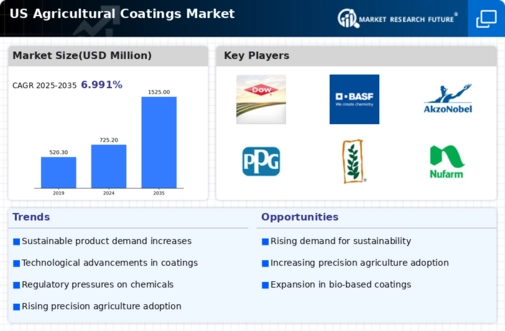The US Agricultural Coatings Market is characterized by its dynamic nature, reflecting the increasing demand for advanced agricultural solutions. This sector has witnessed significant growth, driven by the need for innovative coatings that enhance crop protection, improve product longevity, and optimize efficiency in agricultural practices. Competitively, the market includes a range of players who offer specialized coatings designed to address specific challenges faced by farmers and agricultural businesses.
The competitive landscape is shaped by constant innovation, with companies investing in research and development to formulate new products that meet regulatory standards and consumer demands while also aiming to reduce environmental impact. Additionally, collaborations and partnerships between manufacturers, distributors, and agricultural producers are prevalent as firms seek to gain a competitive edge and expand their market share.FMC Corporation stands as a prominent player in the US Agricultural Coatings Market, recognized for its extensive product portfolio that includes herbicides, insecticides, and fungicides. The company boasts a robust distribution network and a strong reputation for innovation and quality.
FMC Corporation's research-driven approach allows it to consistently develop effective agricultural coatings that cater specifically to the needs of farmers in the US. The company focuses on sustainable agricultural practices and emphasizes environmental stewardship in its product formulations. This commitment not only strengthens the company’s market presence but also aligns with the growing consumer preference for eco-friendly agricultural solutions.
The company's strategic investments in technology and partnerships further enhance its competitive positioning within the market.Sika AG has established itself as a key player in the US Agricultural Coatings Market, leveraging its expertise in specialty chemicals to deliver high-performance coatings suitable for various agricultural applications. The company's offerings include solutions that enhance soil quality, pest resistance, and crop yield, showcasing its commitment to innovation and customer satisfaction. Sika AG's market presence is bolstered by its strategic acquisitions and a well-defined distribution network that allows for efficient product delivery across the US.
The company benefits from strengths such as its strong brand reputation, extensive product range, and focus on research and development, which enable it to stay ahead of market trends. Furthermore, Sika AG actively pursues mergers and acquisitions to expand its product lines and diversify its market offerings, thereby reinforcing its competitive position in the agricultural coatings sector.





















